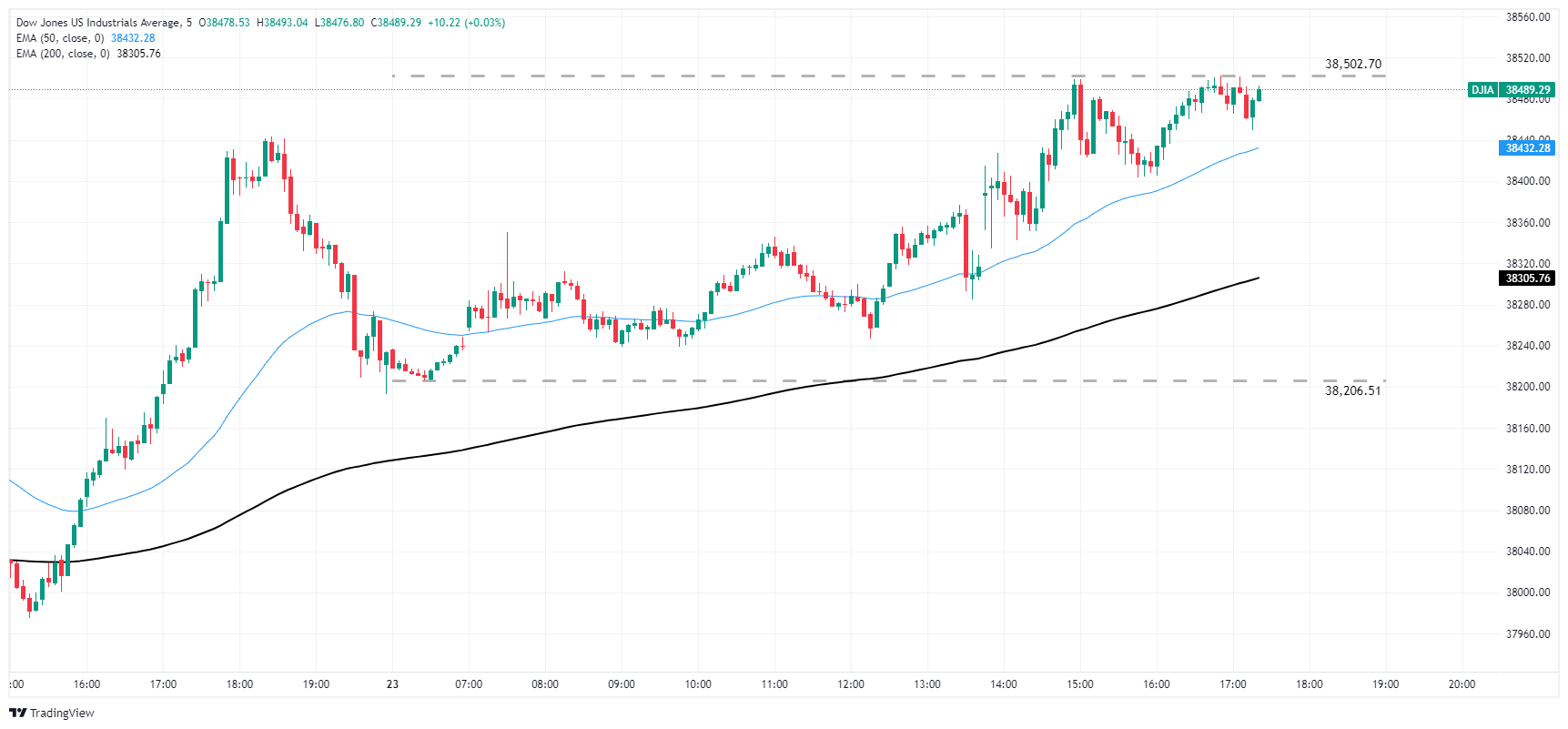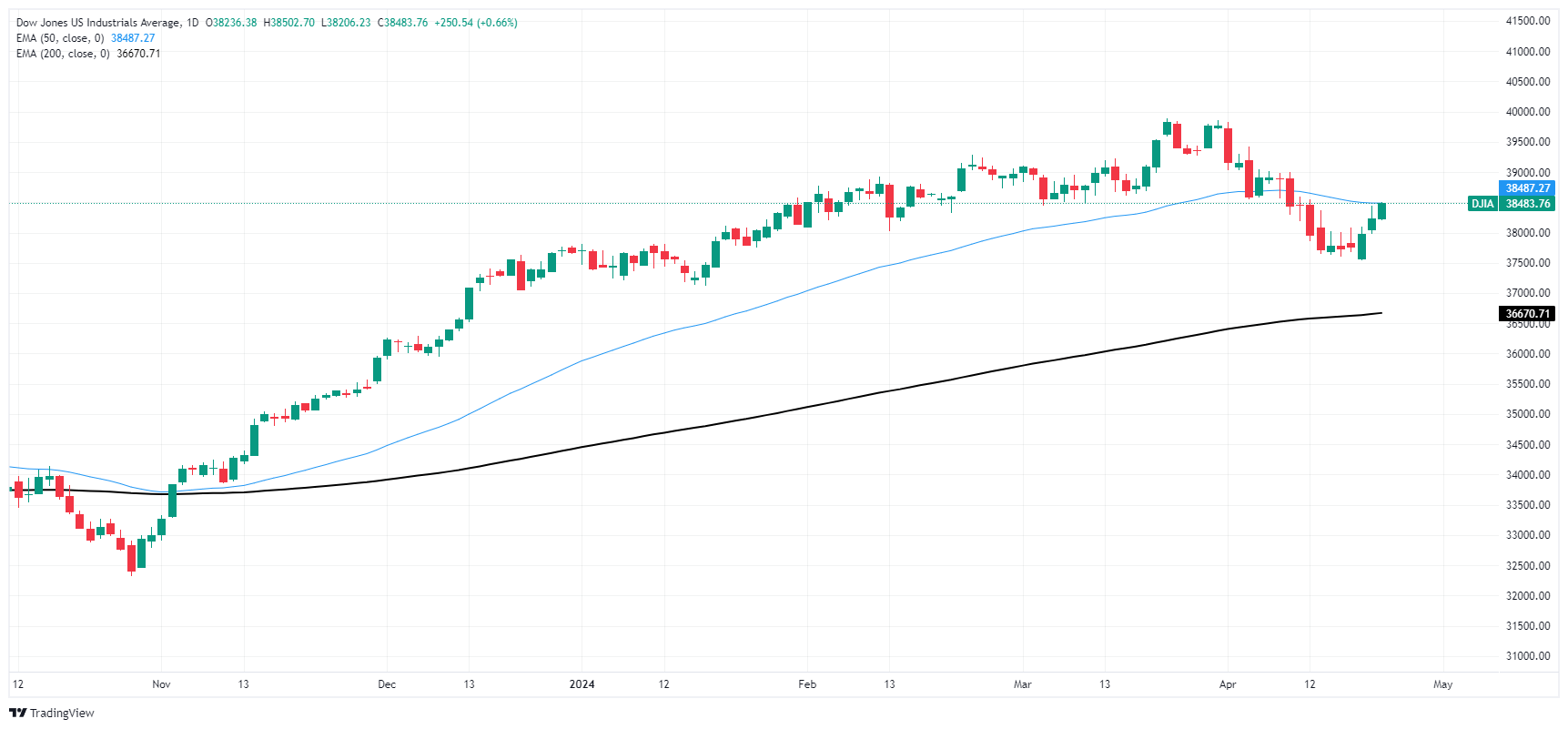- The Dow Jones tests the 38,500 level and US stocks rise.
- US PMI indices weakened, reinforcing hopes for a Fed rate cut.
- Key US GDP and PCE inflation data remain on the table for the week.
He Dow Jones Industrial Index (DJIA) rose on Tuesday after US Purchasing Managers' Index (PMI) numbers unexpectedly softened, bringing broader market hopes for a US Federal Reserve rate cut back to the foreground. US (Fed) ahead of schedule.
The US manufacturing PMI index fell to its lowest level in four months (49.9) on Tuesday, down from 51.9 previously. The services PMI also fell, settling at 50.9 from 51.7 previously. Both components of the PMI were expected to rise to 52.0. With the PMI outlook weakening, investors will be keeping an eye on US Gross Domestic Product (GDP) numbers due on Thursday.
The personal consumption price index (PCE), the Fed's preferred method of measuring inflation, will be released on Friday. Stocks will look for further signs of a slowdown in the US domestic economy to gauge the likelihood that the Fed will be pushed into a larger rate cut cycle than currently anticipated.
US GDP is currently forecast to cool by as much as 2.5% for the first quarter on an annualized basis, while the price index PCE Friday's underlying core is expected to remain stable at 0.3% monthly in March.
Dow Jones News
Despite the gains in US equities overall, the Dow Jones remains tepid compared to the other mega-indices, with the DJIA gaining around seven tenths. Of the 30 stocks that make up the Dow Jones index, nearly a third of them remain in the red on Tuesday, with Walmart Inc. (WMT) leading the losers. WMT loses about 2.5% on the day, trading near $58.60 per share.
Verizon Communications Inc. (VZ) recovers from Monday's decline and rises almost 3.5% to trade near $40.00 per share. VZ is followed by American Express Co. (AXP), which gained 2.5% and is trading near $238.75 per share.
Dow Jones Technical Outlook
The Dow Jones is testing the 38,500.00 level on Tuesday, with the day's low at 38,206.51. The benchmark index is up almost eight percentage points. The main stock index rose almost eight tenths on the day.
Tuesday's rise leaves the Dow Jones on track to close in the green for the third day in a row, as the index rises from a short-term low around 37,600.00 points. The index is still below the March highs, just below the 40,000.00 level, but the index is firmly bullish in the long term. The Dow Jones is trading well above the main technical support of the 200-day EMA at 36,687.91.
DowJones five minute chart.
Dow Jones Daily Chart
Frequently Asked Questions About the Dow Jones
The Dow Jones Industrial Average, one of the world's oldest stock indices, is made up of the 30 most traded securities in the United States. The index is price-weighted rather than capitalization-weighted. It is calculated by adding the prices of the securities that comprise it and dividing them by a factor, currently 0.152. The index was founded by Charles Dow, also founder of the Wall Street Journal. In recent years it has been criticized for not being sufficiently representative because it only follows 30 conglomerates, unlike other broader indices such as the S&P 500.
There are many factors that influence the Dow Jones Industrial Average (DJIA). The main one is the aggregate performance of its component companies, revealed in the companies' quarterly earnings reports. US and global macroeconomic data also contribute, influencing investor sentiment. The level of interest rates, set by the Federal Reserve (Fed), also influences the DJIA, as it affects the cost of credit, on which many companies largely depend. Therefore, inflation can be a determining factor, as well as other parameters that influence the Fed's decisions.
The Dow Theory is a method for identifying the main trend of the stock market developed by Charles Dow. A key step is to compare the direction of the Dow Jones Industrial Average (DJIA) and the Dow Jones Transportation Average (DJTA) and only follow trends where both are moving in the same direction. Volume is a confirmation criterion. The theory uses elements of maximum and minimum analysis. Dow theory postulates three trend phases: accumulation, when the smart money starts buying or selling; public participation, when the general public joins in; and distribution, when the smart money comes out.
There are several ways to trade the DJIA. One is to use ETFs that allow investors to trade the DJIA as a single security, rather than having to buy shares of the 30 companies that comprise it. A prominent example is the SPDR Dow Jones Industrial Average ETF (DIA). DJIA futures contracts allow speculation on the future value of the index, and options give the right, but not the obligation, to buy or sell the index at a predetermined price in the future. Mutual funds allow investors to purchase a portion of a diversified portfolio of DJIA securities, providing exposure to the global index.
Source: Fx Street
I am Joshua Winder, a senior-level journalist and editor at World Stock Market. I specialize in covering news related to the stock market and economic trends. With more than 8 years of experience in this field, I have become an expert in financial reporting.







